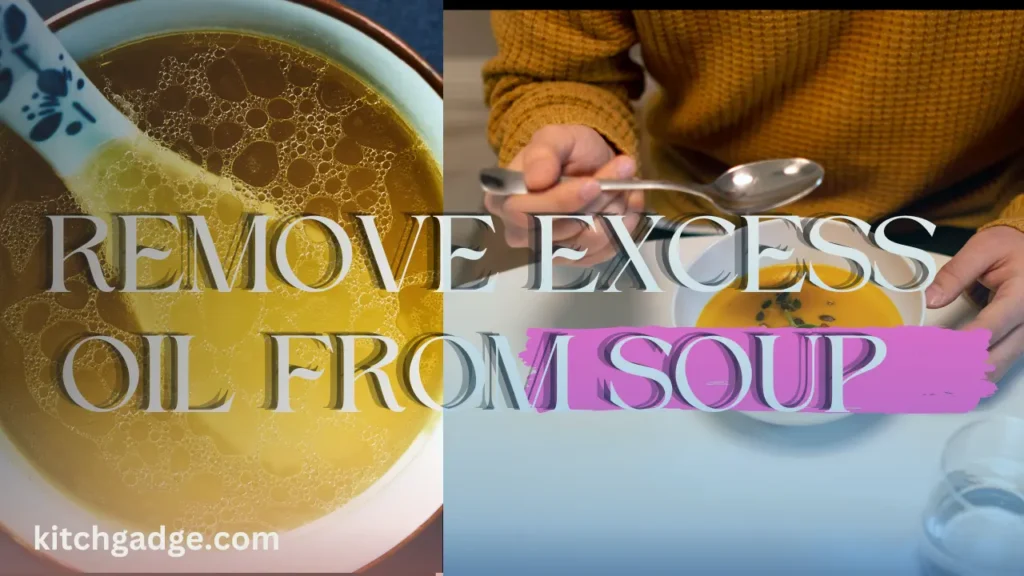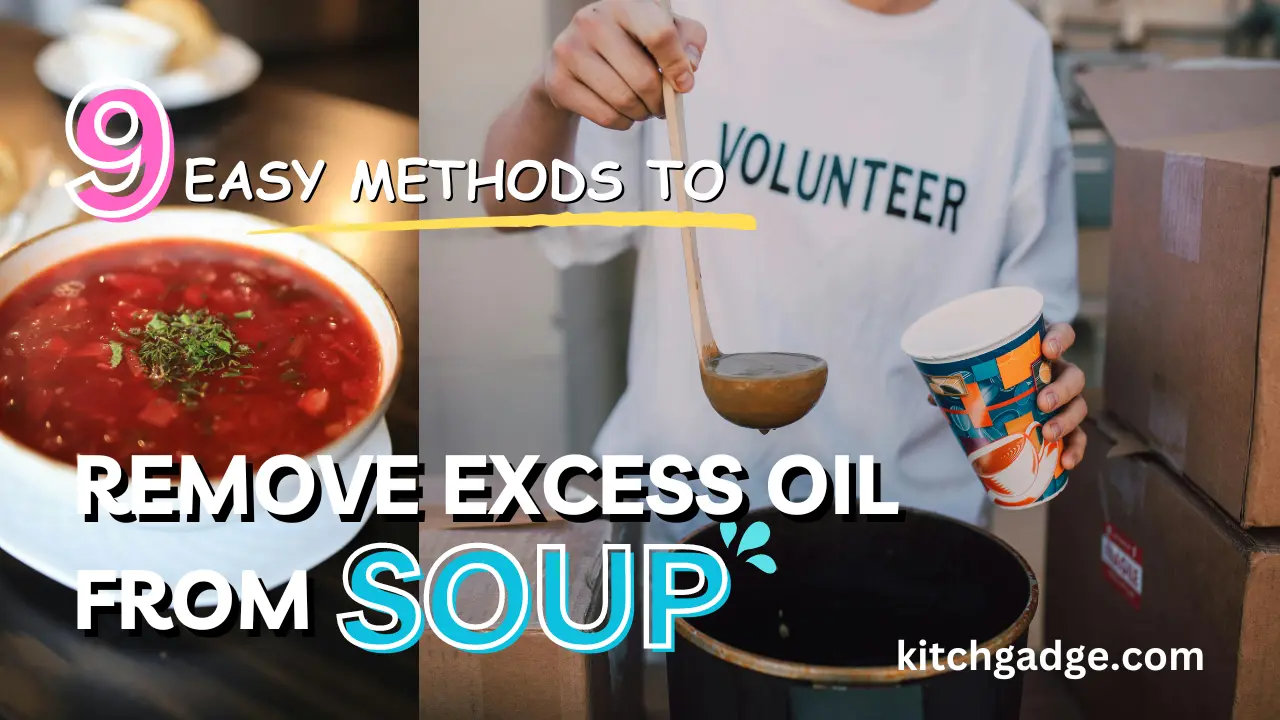remove excess oil from soup like a pro with this technique and tools. You have just crafted a steaming pot of soup, a masterpiece of flavor, making a delicious soup can feel like a work of art. But wait–there’s a problem. A thin layer of oil is present, creating a slick surface.
Not only does it look unpleasant, but it can also weigh down the flavor and texture of your soup.
If so, you’re in the right place. Today, we’re diving into the various techniques and tools you can use to master the art of removing excess oil from soup.

Table of Contents
Why Does Soup Get Oily?
Before jumping into the solutions, it’s helpful to understand why the soup gets oily. Here are a few common reasons:
RELATED POST: How to Get Rid of Too Much Salt in Food
Fatty Ingredients:
Using fatty cuts of meats like chicken, beef, pork, and certain vegetables can release oils during cooking.
Cooking Process:
Long cooking times can break down fats from meats and oils, releasing them into the soup. Using ingredients in oil or adding cream and butter can increase the oil content.
Inadequate Skimming:
If you don’t skim off the fat while cooking, oil can start to build up.
Spices and Add-ins:
Ingredients like curry paste, or coconut milk can also contribute to the oiliness.
Knowing why soup gets oily can help you prevent it. But when you’re already facing an oily disaster, here’s what you can do.
ALSO READ:
10 food preservation methods to reduce waste and save flavor.
Practical Methods to Remove Excess Oil from Soup
1. Skimming the Oil
Using a ladle or a spoon:
- Let the soup sit for a minute to allow the oil to rise to the surface.
- Use a large spoon or ladle to gently skim thesurface. This is most effective when the soup is still hot.
- For more efficient removal, refrigerate the soup to solidify the fat, making it easy to remove with the utensil.
2. Bread Method
- Float a piece of bread on the surface of the soup. It will absorb some of the excess oil. The bread will soak up the oil without affecting the soup’s flavor.
- Remove the bread once it becomes saturated and discard.
This method is quick and works best when there’s a thin layer of oil.
3. Using Ice Cubes
This one’s a bit unconventional, but it’s incredibly effective
- Gather some ice cubes and carefully envelop them in a cheesecloth or a spotless piece of paper towel.
- Then quickly dip the cold will make the oil harden and stick to the fabric, making it easy to remove.
4. How to Skim Fat from Chilled Broth
Refrigeration Method
If you’ve got the time, this method is perfect.
One effective way to remove oil is to chill the soup. When the soup cools, the fat solidifies on top, making it easy to remove.
- Let the soup cool to room temperature. Then refrigerate it for a few hours.
- Freezing the broth can also help. Once frozen, the fat separates and solidifies, making it easy to break off and discard.
- After a few hours, the oil will solidify on top. Simply scoop it off with a spoon.
This method is ideal for making large batches of soup in advance.
5. Lettuce Leaves
Believe it or not, Lettuce isn’t limited to salads, it can also serve as an oil-absorbing agent.
- Simply place a few large lettuce leaves on the surface of the soup. To attract and absorb excess oil.
- Remove the leaves once they have absorbed the oil.
This method works well for soups with a moderate amount of oil.
6. Using Waxed Paper
- Place a piece of waxed paper on the surface of the soup. The fat will stick to the paper, enabling easy removal. allowing you to lift it off
- This hack reduces fat content, enhancing your soup’s healthiness.
7. Cornstarch Slurry
This method not only removes oil but can also thicken your soup.
- Cornstarch Slurry: Mix cornstarch with cold water to form a slurry. Add it to the soup while stirring constantly. The cornstarch will bind with the oil, and as you skim off the surface, it will take the oil with it.
- This method enhances flavor and texture, perfect for soup a culinary upgrade.
8. Clarification with Egg Whites
- Whisk egg whites and stir them into the hot soup. As they cook, they will trap fat and impurities, which can then be strained out.
- This method not only refines the appearance but also enhances the flavor profile and delicious soup.
Preventing Excess Oil in Soup
Now that we’ve covered how to remove excess oil, let’s look at how to prevent it in the first place:
1. Trim the Fat
Before cooking, trim visible fat from meats. This reduces the amount of oil that ends up in your soup.
2. Measure Your Oil
Be mindful of how much oil you add when sautéing. A little goes a long way.
3. Use Lean Proteins
Opt for lean meats or plant-based proteins that don’t release much fat.
4. Choose Low-Fat Dairy
If your recipe requires cream, consider using low-fat alternatives or evaporated milk.
5. Cook at a Lower Temperature
Cooking at a lower temperature can prevent oil separation from the ingredients.
Adjusting oil content not only boosts flavor but also upgrades the health benefits of your dish.
The Importance of Oil Control in Soup
Why Excess Oil in Soup is a Problem
Excess oil in soup can lead to:
- Unpleasant Mouthfeel: Greasy soups can feel heavy and unappealing in the mouth.
- Health Concerns: High-fat content contributes to unnecessary calories, posing health risks. Excess oil can cause weight gain and heart problems.
- Aesthetic Issues: an oily layer on top can detract from the dish’s visual appeal.
When Oil is Necessary
Oil has its benefits, remember that:
- Flavor: Some oil enhances the test and depth of flavor.
- Texture: It can add a silky texture to your broth.
The Importance of Oil-Free Soup
Health Benefits of Removing Excess Oil
Reducing the oil in your soup isn’t about appearances or taste, it’s a health decision. Excessive oil consumption can contribute to various health issues, including weight gain and heart problems. Removing excess oil makes your soup lighter and healthier without sacrificing flavor.
FAQ
Can I use a regular spoon to skim the oil off my soup?
Absolutely! A regular spoon works just fine. For larger quantities, a ladle might be more efficient.
Will removing the oil affect the flavor of my soup?
Removing excess oil can enhance the flavor by preventing the soup from being overly greasy, ensuring a more delightful test experience. The key is to balance, not to remove all the oil.
How often should I use the paper towel method?
As often as needed until you’re satisfied with the oil level. Just be cautious not to absorb too much broth in the process, maintaining the soup’s rich flavor.
Are there soups that naturally have less oil?
Yes, soups that rely more on vegetables and lean proteins tend to have less oil compared to those with fatty meats and creamy bases.
What are the best tools for beginners to remove excess oil from soup?
Starting with the spoon-skimming or ladle method is the easiest. you can experiment with other techniques like the ice cube trick or using a bread slice.
Why is my soup oily even after skimming?
your soup might still be oily due to high-fat ingredients, and insufficient skimming, ensure thorough skimming and consider using leaner ingredients to reduce oiliness.
Conclusion
Managing oil in a soup might seem daunting, but with these techniques, transforming it into a simple task. Skimming, absorbent methods, and prevention tips ensure your soup remains delicious and healthy. Remember, it’s all about balance and control.
ALSO READ:
13 Incredible Benefits of Cucumber Water: How to Make It and Delicious Recipes
5 quick and easy onion peeling techniques: say goodbye to tears.
Unlocking Savings: how the 5-4-3-2-1 Method Can Transform Your Budget.
